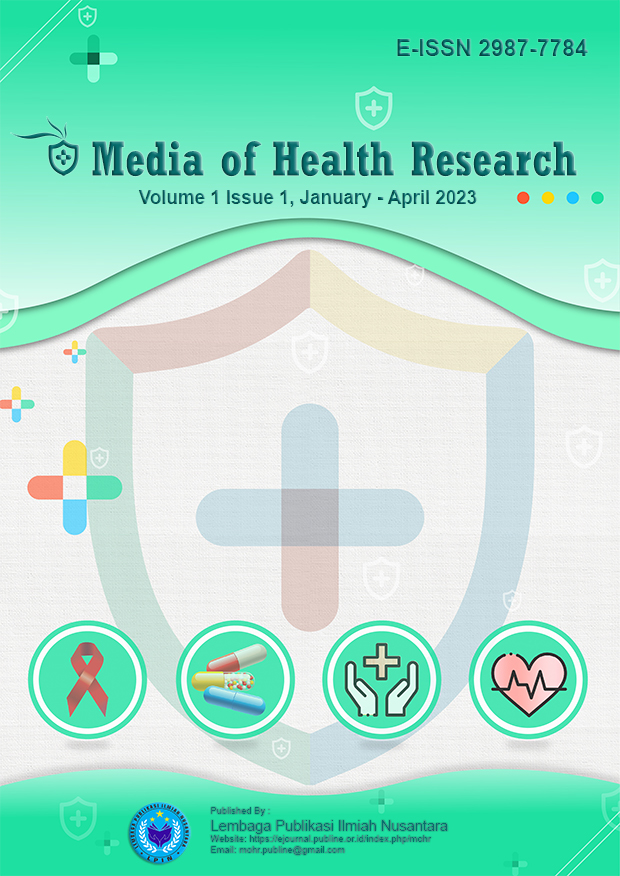Perbedaan Posisi Miring dan Setengah Duduk pada Ibu Bersalin terhadap Kelancaran Persalinan Kala II di RB Puskesmas Kecamatan Matraman Tahun 2021
DOI:
https://doi.org/10.55681/mohr.v1i1.6Keywords:
AKI, Perineal Rupture, Post PartumAbstract
Maternal mortality is death that occurs during pregnancy, childbirth and the postpartum period due to certain causes. Indonesia is in the third highest rank for Maternal Mortality Rate (MMR) in ASEAN countries. The first rank is Laos with 470/100,000 live births, while the lowest is Singapore with 3/100,000 live births. This study is an experimental study of static group comparison (static group comparison), namely observing the quasi-experimental group (delivery position tilted to the left) and the experimental group (sitting position of labor). It was found that there was a difference in the average value of the second stage of labor between the half-sitting and left-sided labor positions. The second stage in the standing position group was 26.87 minutes, while the second stage in the left tilted position group was 23.60 minutes, with a difference in the average value of 3.27 minutes. The half-sitting position has advantages, namely the birth canal groove that needs to be achieved to be able to get out shorter and the earth's gravity to lower the fetus into the pelvic cavity. While the tilted position to the left has the advantage of providing a relaxed feeling for the mother to get the baby out. However, from the results of hypothesis testing using an independent T test, it was found that the p value: 0.670 > alpha (0.05) which means that there is no significant difference between the exercise position and tilted to the left on monitor II.
Downloads
References
A.B, Saifuddin, T., Rachimhadhi, & Wiknjosastro, G. H. (2014). Ilmu kebidanan Sarwono Prawirohardjo (Edisi ke-4, Cetakan ke-3). Jakarta: PT Bina Pustaka Sarwono Prawirohardjo.
Departemen Kesehatan Republik Indonesia. (2016). Profil kesehatan Indonesia 2015. Jakarta: Departemen Kesehatan RI.
Dinas Kesehatan Provinsi Banten. (2015). Profil kesehatan Dinas Kesehatan Provinsi Banten tahun 2015. Banten: Dinkes Provinsi Banten. https://dinkes.bantenprov.go.id/upload/article_doc/TABEL_PROFIL_PROV_2015.pdf
Firdaus, H. L. (2018). Asuhan kebidanan continuity of care pada Ny. “H” mulai masa hamil sampai dengan pelayanan kontrasepsi di BPM Bidan “N” wilayah Arosbaya [Doctoral dissertation, Poltekkes Kemenkes Surabaya].
Hidayat, A. A. (2021). Proses keperawatan: Pendekatan NANDA, NIC, NOC dan SDKI. Health Books Publishing.
Kartiyem, K. (2022). Asuhan kebidanan berkesinambungan pada Ny. S usia 32 tahun G1P0A0AH0 hamil 40 minggu 4 hari di PMB Kartiyem, Pengasih, Kulon Progo [Doctoral dissertation, Poltekkes Kemenkes Yogyakarta].
Lestari, T. (2016). Asuhan keperawatan anak. Yogyakarta: Nuha Medika.
Maysaroh, S., & Mariza, A. (2021). Pengetahuan tentang keputihan pada remaja putri. JKM (Jurnal Kebidanan Malahayati), 7(1), 104–108. http://dx.doi.org/10.33024/jkm.v7i1.3582
Notoatmodjo, S. (2012). Metodologi penelitian kesehatan. Jakarta: Rineka Cipta.
Prawirohardjo, S. (2016). Buku ilmu kebidanan (Edisi ke-4). Jakarta: PT Bina Pustaka Sarwono Prawirohardjo.
Puspitasari, D. (2017). Asuhan kebidanan continuity of care pada Ny. S masa hamil sampai dengan keluarga berencana di BPM Yuni Siswati, S.ST, Ngampel Balong Ponorogo [Doctoral dissertation, Universitas Muhammadiyah Ponorogo].
Rifka Fatimah, H. (2021). Asuhan kebidanan berkesinambungan pada Ny. E usia 30 tahun G4P3AB0AH3 dengan anemia ringan dan paritas berisiko di Puskesmas Depok 3 [Doctoral dissertation, Poltekkes Kemenkes Yogyakarta].
Rukmi, D. K., Dewi, S. U., Pertami, S. B., Agustina, A. N., Carolina, Y., Wasilah, H., & Lubbna, S. (2022). Metodologi proses asuhan keperawatan. Yayasan Kita Menulis.
Saifuddin. (2009). Buku acuan nasional pelayanan kesehatan maternal dan neonatal. Jakarta: YBP-SP.
Santoso, D., Cahyani, E. D., & Murniati, M. (2022). Asuhan keperawatan hipertermia pada An. S dengan febris di ruang Firdaus RSI Banjarnegara. Jurnal Inovasi Penelitian, 3(7), 6915–6922. https://doi.org/10.47492/jip.v3i7.2196
Tim Pokja SDKI DPP PPNI. (2017). Standar diagnosis keperawatan Indonesia: Definisi dan indikator diagnostik. Jakarta: Dewan Pengurus PPNI.
Tri Widyastuti, L. T. (2016). Asuhan kebidanan continuity of care pada Ny. S masa hamil sampai dengan KB di BPM Setyami [Doctoral dissertation, Universitas Muhammadiyah Ponorogo].
Wahyuni, T., & Hanna, R. A. (2017). Hubungan antara kadar hemoglobin ibu hamil trimester III dengan berat badan janin di Puskesmas Trauma Center Samarinda. Jurnal Ilmu Kesehatan, 5(2), 137–143. https://doi.org/10.30650/jik.v5i2.64
Widyastuti. (2010). Asuhan kebidanan pada ibu bersalin. Yogyakarta: Fitramaya.
Widyastuti, M. D. (2020). Asuhan kebidanan pada Ny. “I” masa kehamilan trimester III, persalinan, nifas, neonatus dan KB pascasalin di PMB Hj. Sunarsih, MM Sawahan Kabupaten Madiun [Doctoral dissertation, STIKES Bhakti Husada Mulia Madiun].
Yani, D. F., & Duarsa, A. B. S. (2013). Pelayanan kesehatan ibu dan kematian neonatal. Kesmas, 7(8), 373–377. https://doi.org/10.21109/kesmas.v7i8.24
Yugistyowati, A., & Santoso, S. (2018). Pengetahuan perawat tentang family centered-care dengan sikap dalam pemberian asuhan keperawatan di ruang rawat inap anak. Jurnal Keperawatan Respati Yogyakarta, 5, 39–44. https://doi.org/10.35842/jkry.v5i0.285
Downloads
Published
How to Cite
Issue
Section
License
Copyright (c) 2023 Media of Health Research

This work is licensed under a Creative Commons Attribution-ShareAlike 4.0 International License.











